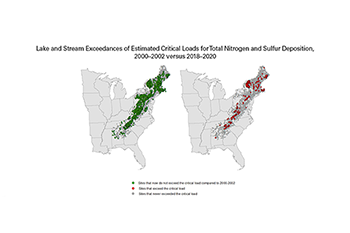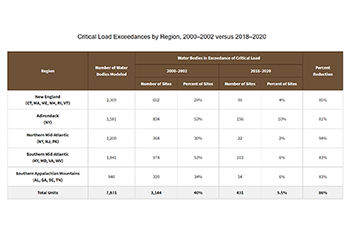Progress Report
Ecosystem Response
Critical Loads Analysis Figures
Last updated: 01/2022
Related Figures


Highlights
Critical Loads and Exceedances
- For the period from 2018 to 2020, 5.5 percent of the 7,871 studied lakes and streams still received levels of combined total sulfur and nitrogen deposition exceeding their calculated critical load. This is an 86 percent improvement over the period from 2000 to 2002 when 40 percent of all studied lakes and streams exceeded their calculated critical load.
- Emission reductions achieved between 2000 and 2020 have contributed and will continue to contribute to broad surface water improvements and increased aquatic ecosystem protection across the five LTM regions along the Appalachian Mountains.
- Based on this analysis, current sulfur and nitrogen deposition loadings in 2020 still exceed levels required for recovery of some lakes and streams, indicating that some additional emission reductions are necessary for some acid-sensitive aquatic ecosystems along the Appalachian Mountains to recover and be protected from acid deposition.
Background Information
A critical loads analysis is an assessment used to provide a quantitative estimate of whether acid deposition levels resulting from SO₂ and NOₓ emissions are sufficient to protect ecosystem health. The analysis here focuses on aquatic biological resources. If acidic deposition is less than the calculated critical load, harmful ecological effects (e.g., reduced reproductive success, stunted growth, loss of biological diversity) are not expected to occur, and ecosystems damaged by past exposure are expected to eventually recover.1
Lake and stream waters having an ANC value greater than 50 μeq/L are classified as having a moderately healthy aquatic biological community; therefore, this ANC concentration is often used as a goal for ecological protection of surface waters affected by acidic deposition. In this analysis, the critical load represents the amount of combined sulfur and nitrogen that could be deposited annually to a lake or stream and its watershed and still support a moderately healthy aquatic ecosystem (i.e., having an ANC greater than 50 μeq/L). Surface water samples from 7,871 lakes and streams along acid-sensitive regions of the Appalachian Mountains and some adjoining northern coastal plain regions were collected through a number of water quality monitoring programs. Critical load exceedances were calculated using the Steady-State Water Chemistry model.2,3
More Information
- Surface water monitoring at EPA
- National Acid Precipitation Assessment Program (NAPAP) Report to Congress Exit
References
- Dupont, J., Clair, T.A., Gagnon, C., Jeffries, D.S., Kahl, J.S., Nelson, S.J., & Peckenham, J.M. (2005). Estimation of critical loads of acidity for lakes in the northeastern United States and eastern Canada. Environmental Monitoring and Assessment, 109:275–291.
- Sullivan, T.J., Cosby, B.J., Webb, J.R., Dennis, R.L., Bulger, A.J., & Deviney, Jr. F.A. (2007). Streamwater acid-base chemistry and critical loads of atmospheric sulfur deposition in Shenandoah National Park, Virginia. Environmental Monitoring and Assessment, 137: 85–99.
- Nilsson, J. & Grennfelt, P. (Eds) (1988). Critical loads for sulphur and nitrogen. UNECE/Nordic Council workshop report, Skokloster, Sweden. Nordic Council of Ministers: Copenhagen.